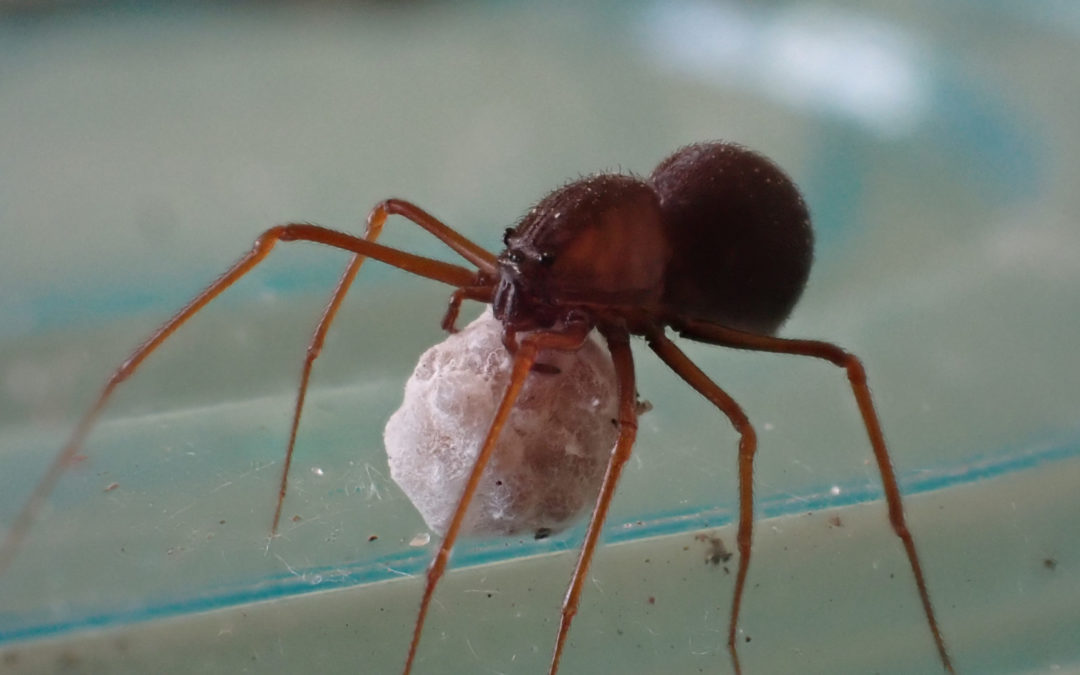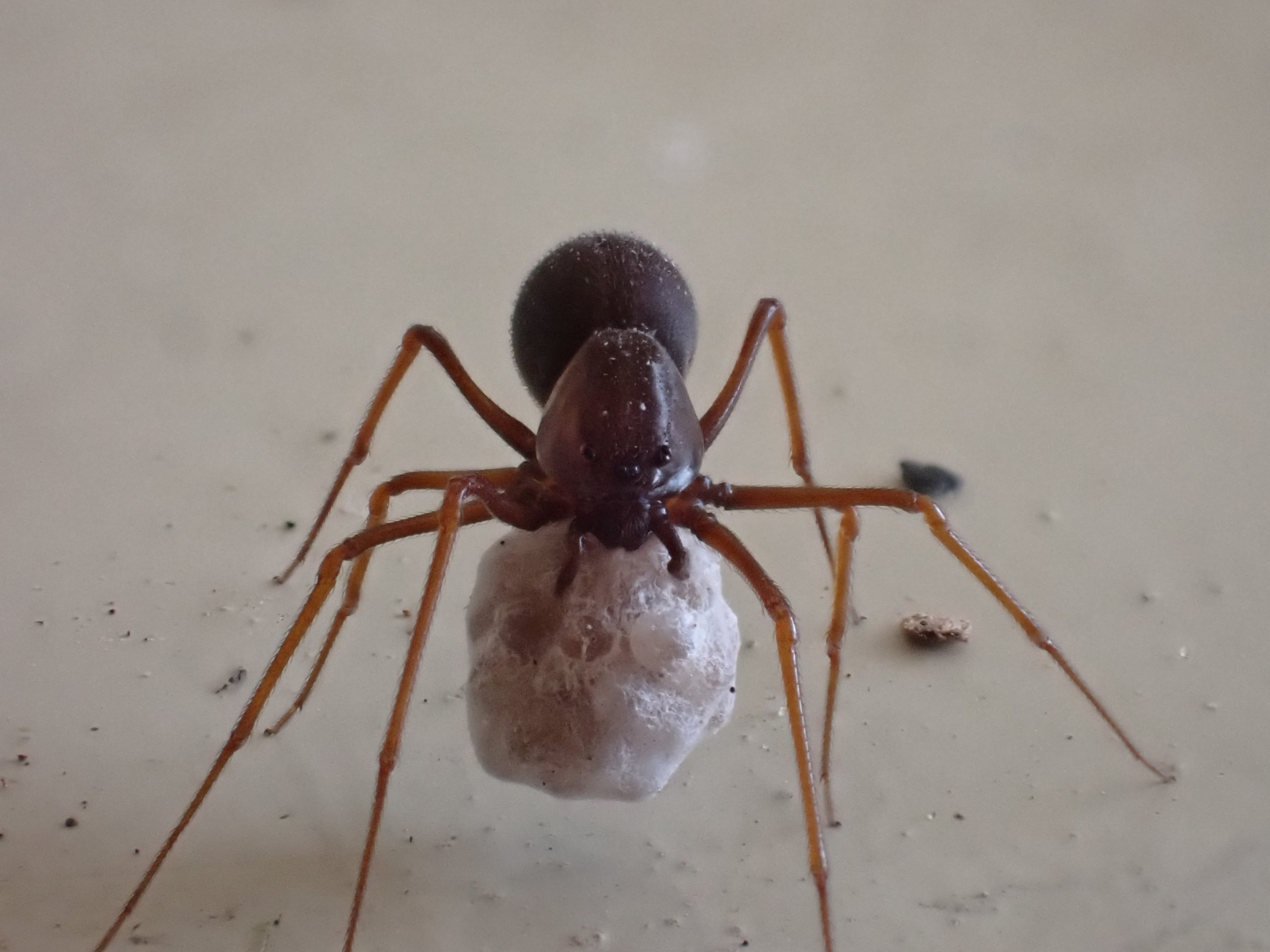
Arizona Blonde Tarantula
Did you know that the Arizona Blonde Tarantula (Aphonopelma chalcodes) is the largest species of spider in North America? Watch the video to learn more!

Did you know that the Arizona Blonde Tarantula (Aphonopelma chalcodes) is the largest species of spider in North America? Watch the video to learn more!

The spiders belonging to the family Scytodidae, commonly known as Spitting Spiders, are some strange arachnids. Not only do they have six eyes instead of the usual eight, but they hunt by “spitting” a mixture of sticky silk and venom onto their prey! There are over 250 different species of Spitting Spiders, all of which grow to about 6mm in length.

Spitting Spider carrying an egg sac (the white thing).
To hunt, the Spitting Spider slowly creeps to about 1/3 of an inch away from its target, and when its ready, shoots a stream of silky fluid out of its fangs and onto its target in a zigzag pattern, effectively gluing the prey item, such as an ant, to the ground. The Spitting Spider then cautiously moves in and administers a killing bite, then backs away to wait until the venom does its work and the prey stops moving before starting to eat it.

The front of a Spitting Spider. Note the three groups of two eyes on the cephalothorax.
Sadly, Spitting Spitting spiders are often killed by humans because they are mistaken for Brown Recluse Spiders, because of their brown coloration and six eyes, but in reality, Spitting Spiders are completely harmless. To tell these two apart, look for the signature dome-shaped cephalothorax of the Spitting Spider. Spitting Spiders can be found on most continents, including North America, where they live under rocks, logs, or in and around homes, where they capture and eat pest insects such as cockroaches, flies, and termites.

There are over 2,000 species belonging to the family Lycosidae, commonly known as Wolf Spiders. Wolf Spiders vary in size and coloration, but there are two things all of them have in common. One is their incredible speed and agility, and the other is the huge front pair of eyes. This combination of speed and sight is perfect for chasing down prey items, such as crickets, cockroaches, and other spiders, and when the roles are reversed and the wolf spider becomes the intended target of a predator such as a bird or lizard, help the spider make a speedy getaway.

The front end of a Tiger Wolf Spider (Hogna aspersa). Notice the large front eyes.
Wolf spiders are very common, living on every continent except Antarctica. They range in color from black to almost white. One species, Hogna carolinensis, even has orange chelicerae! Wolf Spiders are usually not that big, and often go unnoticed, although some species can get 2-3 inches in length! Wolf Spiders are commonly mistaken for Brown Recluse Spiders (Loxosceles reclusa) because of their brown color, and because some have a violin shaped mark on their cephalothorax, which is considered trademark of the Brown Recluse. The best way to tell these two spiders apart is to look for the large eyes of the wolf spider.

A small juvenile Thin-Legged Wolf Spider. It’s coloration blends in perfectly with the background.
The venom of a Wolf Spider is not dangerous, but i can be mildly painful if you are bitten. Wolf spiders are commonly found in or around houses, especially where there is moisture readily available, such as bathrooms and basements. Though they look intimidating, Wolf Spiders are extremely beneficial, as they kill and eat many pest insects, such as cockroaches and beetle larvae. If you want to easily find Wolf Spiders, go outside to an open field on a warm, summer night and shine a flashlight on the ground ahead of you. Their large front eyes will glow back at you!

Did you know that scorpions actually glow under Ultraviolet Light? Watch the video to find out more!
Because of their relatively small size, bugs need an effective strategy to keep predators at bay. Most accomplish this by stinging, biting, or having hard exoskeletons, but some have very unusual ways to evade their enemies. One example is the Goliath Birdeater Tarantula (Theraphosa sp.). These enormous spiders are able to rub their massive fangs together to produce an audible hissing noise to scare off attackers. On top of that, Goliath Birdeaters, along with many New World tarantulas (New World meaning from the Americas, Old World meaning coming from everywhere else) possess the ability to “kick hairs”. When threatened, they will rub their back legs rapidly on their abdomen, flinging off a cloud of miniscule barbed hairs into the air. These hairs, known as Urticating Hairs, float in a cloud around the tarantula and stick in the eyes, nose, and skin of the predator, causing itching and redness. Some of the larger species, particularly those in the genus Theraphosa, have Urticating Hairs that feel like fiberglass! Ouch! Tarantulas in the genus Avicularia, commonly known as the Pinktoe Tarantulas, have another weird way that they defend themselves. If threatened, these spiders can shoot a stream of excrement at their attackers! This tactic is as effective as it sounds. Gross! The Bombardier Beetle truly lives up to its name. When attacked, this sharpshooter fires boiling liquid out of its abdomen at its enemies! They can do this thanks to a special chemical reaction chamber located in the beetle’s abdomen. This strategy is so effective that there is even a species of beetle, Galerita bicolor, that mimics the Bombardier Beetle so that predators confuse G.bicolor with its lookalike gunslinger and leaves it alone. Have you ever picked up a fuzzy-looking caterpillar and then have your arm break out in a rash? This is because the “furs” are actually venomous spines! Many caterpillars have these spines, although they are mostly moth caterpillars that use this tactic. These are just a few of the amazing ways that some bugs use to live to jump, fly, or crawl another day.
Recent Comments